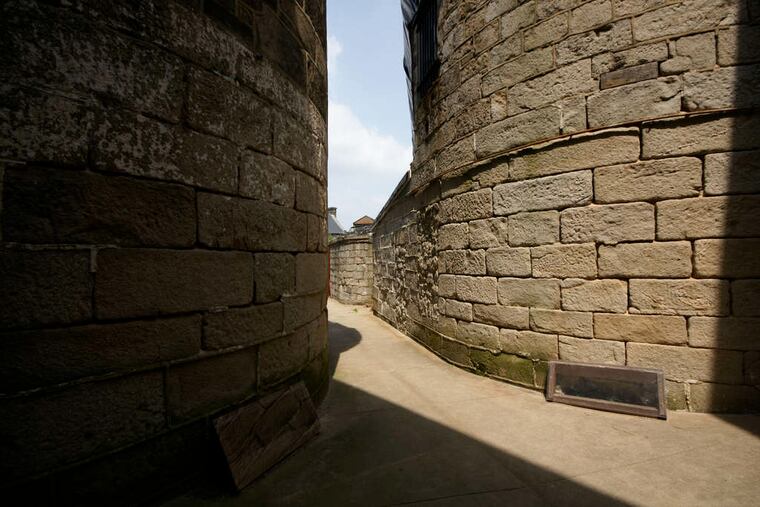Reconnecting with Philadelphia's past
Beth Kephart is the author of the illustrated novel "Dr. Radway's Sarsaparilla Resolvent" (due in May from New City Community Press/Temple University Press), which takes place in 1871 Philadelphia

Beth Kephart
is the author of the illustrated novel "Dr. Radway's Sarsaparilla Resolvent" (due in May from New City Community Press/Temple University Press), which takes place in 1871 Philadelphia
Shortly after I graduated from the University of Pennsylvania, I rented the first floor of a redbrick rowhouse near the corner of 28th and Poplar. Up three short steps, through a keyhole arch and in, to a surprisingly generous front room made twice its size by the largest mirror I'd ever seen. It was as if a troupe of ballerinas had lived there first. Even with my roommate gone, I was never actually alone. There were two of me alongside the ghosts of a thousand skinny arms.
I'd talked my way into a marketing job at an architecture firm in the Reading Terminal Headhouse, though my only qualification was a familial association with the man who had designed the Waldorf Astoria, the Pierre, and other mysterious landmarks. Between the apartment and the job lay Fairmount and Spring Garden. I walked the distance every working day, a jigsaw pattern running east and south just after dawn, then west and north as the sun was setting.
I was already in love with Philadelphia. This was my chance to see her new. To imagine myself within the churn and thrum of her machine past, to find some kind of proof of the blacksmiths, ironworkers, tool workers, steam handlers, pattern makers, and sewing-machine makers who had lived there once - employees of Philadelphia's vast industrial complex.
Greater and more famous than all the other enterprises was Baldwin Locomotive Works, whose smokestacks spewed and whose buildings clattered and hummed with the piece-by-piece assembly of steam locomotives and street-railway cars. At the peak of its powers, according to Baldwin historian John K. Brown, the company's shops occupied seven full city blocks west of Broad and south of Spring Garden, before finally moving to Eddystone in 1928. To walk those streets was to squint toward then - to wonder how something so alive and thriving, so vast and reverbing, could be silenced and nearly vanquished by time.
If I walked down Hamilton, between 21st and 20th, and looked north toward what is today City View Condominiums, I could imagine the women of Preston Retreat, a maternity hospital for women who did not have the funds for proper care. The grand façade was gone, the catalpa trees, the garden. The rise in the hill remained.
If I walked the bridges and looked down, I could see the rusted tracks of the old railroad - overgrown by green and brambly things. If I walked by the U.S. Mint I could imagine the colonial-era refugees of yellow fever making their way to the slight elevations here, in hopes of a cure.
But no matter how I walked I was always sure to walk down 22d or Fairmount or Corinthian - streets that carried me past the impenetrable walls of Eastern State Penitentiary. "Grave, severe, and awful," the building had been called in the pages of an otherwise cheery late-19th-century guide to Philadelphia. "The effect which it produces on the imagination of every passing spectator is peculiarly impressive, solemn, and instructive."
How true that was. I was young and on my own, an unforeseeable life before me. If it was impossible for me to know what lay beyond the imposing edifice, what history resonated in the guard tower above, what seeds had grown to trees within the cells and labor yards, what work vandals and gravity had done since the last inmates had been driven away many years before, it was easy to imagine the restlessness, regret, and rage that had trembled in that space. The yield of wrong choices.
I would move to two more city apartments before making a life out in the suburbs. I would return to those streets in later years to visit friends. I would watch as what remained was brilliantly reclaimed. As a task force of architects, historians, and preservationists would begin the process of rescuing Eastern State from cruel proposals and long neglect, of opening the building for tours and to movie directors, of initiating a haunted Halloween tradition that would, in time, become world famous, of inviting artists to create living installations.
I would watch as a local historian named Harry Kyriakodis would begin offering walking tours in celebration of this postindustrial swath. As an enterprising nonprofit called Viaduct Greene would begin to advocate for something it calls "a garden of intersecting culture and wildness along the soaring and submersive landscape infrastructures" within the former tracks of the Philadelphia and Reading Railroad. As Matthias Baldwin, that magnificent man (bighearted, so generous, a lover of orchids) was at long last remembered in an urban park that bears his name.
What would this swath of Philadelphia be if all the industrial buildings of her remarkable past had been rescued from the bulldozer and converted into something both respectable and right? Why are we a city of greater integrity because radical preservationists and innovative planners and generous philanthropic organizations saved Eastern State from the wrecking ball and vandals? What would happen if Philadelphia were finally granted her own "linear garden-park," an uninterrupted, three-mile stretch for pedestrians and cyclists?
We can never reclaim what we give away, but we can celebrate what we rescue. We can look in the mirror and see the ghosts, then turn around and face them.